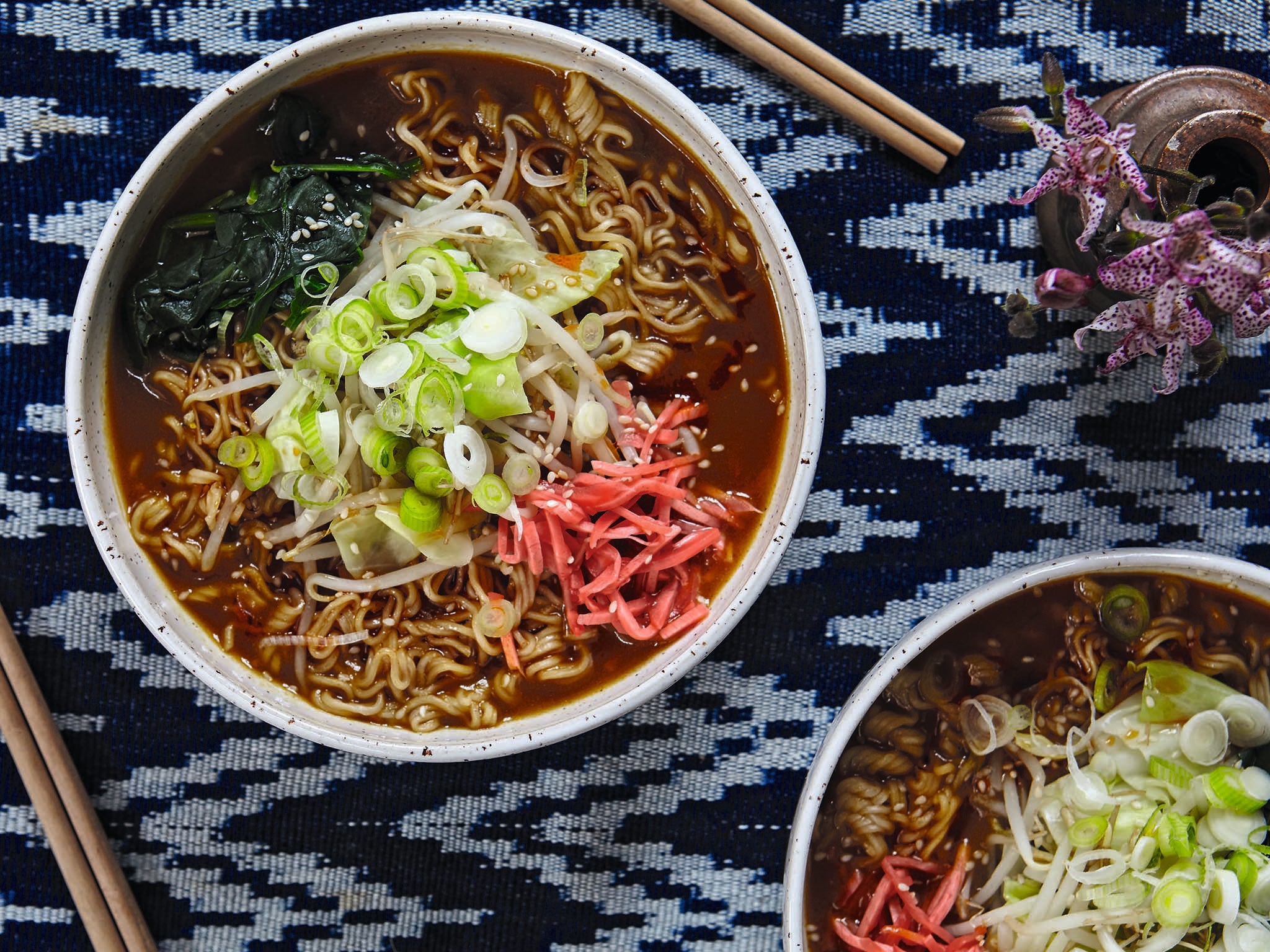‘Vegan JapanEasy’ recipes: From curry ramen to ‘primavera’ fried rice
You can still slurp down that udon and munch on that nori with Tim Anderson’s plant-based versions of classic dishes

Curry ramen
Serves 4
The noodle most commonly paired with curry in Japan is udon, which is nice, but personally I’d like to see a lot more curry ramen, starting with this one. I think the viscosity of Japanese curry broth makes it a natural partner for ramen, which is usually served with meaty broths that have a lot of body from fat and collagen. But to be honest you can use whatever noodle you like here – it’s not exactly a “traditional” dish, so you won’t run afoul of the Japanese culinary authenticity police if you make it with udon or somen instead of ramen.
1.2l dashi or seasoned vegetable broth
200g Japanese curry roux (see below)
3-4 tbsp soy sauce (to taste)
hot chilli sauce, to taste
100g fresh spinach
½ hispi (pointed) cabbage, cut into strips about 1cm wide
150g bean sprouts
4 portions of uncooked ramen noodles
4 spring onions (scallions), finely sliced
a few big pinches of sesame seeds
about 60g red pickled ginger
a few spoonfuls of chilli oil or sesame oil (to taste)
Bring the dashi or broth to the boil and whisk in the curry roux, soy sauce and chilli sauce. Let the mixture boil for a few minutes until it thickens up nicely, then reduce to a low simmer, drop in the spinach, and place a lid on the pan. Bring a large pot of water to the boil and blanch the cabbage and bean sprouts for 1-2 minutes, then remove with a slotted spoon or a sieve (fine mesh strainer) and reserve. Let the water come back up to a rolling boil, then cook the ramen until al dente, according to the packet instructions. Drain well.
Divide the ramen among 4 deep bowls and ladle over the soup and spinach. Use chopsticks to gently stir the noodles through the soup, then top with the cabbage and bean sprouts, spring onions, sesame seeds, pickled ginger and chilli or sesame oil.
Japanese curry roux (aka not katsu sauce)
Makes 200g, enough for 4 servings
3 tbsp coconut oil
3 tbsp vegetable oil
1 small onion, finely diced
½ small, ripe banana, diced
1 tablespoon tomato puree (paste)
1 tablespoon peanut butter or similar nut butter
60g plain (all-purpose) flour
2 tablespoons curry powder
2 tablespoons garam masala
2 tablespoons nutritional yeast (optional)
Heat the coconut and vegetable oils together in a saucepan over a medium heat, then add the onion and saute until soft and slightly brown. Add the banana and continue to cook until the banana browns and starts to break apart. Add the tomato puree, peanut butter, flour, spices and yeast flakes (if using) and cook for another 5 minutes, stirring constantly, until the spices have softened and the fat has absorbed the flour. Transfer to a food processor or use a handheld stick blender to puree the roux. Leave to cool, then divide into 50g portions and transfer to the refrigerator, where it will keep for about a week, or to the freezer, where it will keep for several months.

Crispy fried aubergine with spicy miso sauce
Serves 2, or 1 if this is your dinner, probably while watching netflix
This is essentially the flavours of the classic nasu dengaku – sweet miso-glazed aubergine – spiked with a bit of chilli and translated into an addictive, snacky format. I think I like them especially because they remind me so much of me – with a hardened outer shell that’s easily broken to reveal a soft and squishy middle. Aonori are green nori seaweed flakes, typically used as a garnish. If you can’t get them you can leave them out of most recipes and it won’t be a disaster, but you can also blitz up a sheet of sushi nori in a spice grinder, or snip it into little shreds with scissors, to get a similar effect.
6 tablespoons sweet miso sauce (see below)
juice of ¼ lemon
hot chilli sauce, to taste
1 aubergine
80g plain (all-purpose) flour
2 eggs’ worth of vegan egg replacer
about 100g panko breadcrumbs
oil, for deep-frying (about 1l)
pinch of salt
a few pinches of aonori (optional)
Stir together the sweet miso sauce, lemon juice and chilli sauce; taste and add more chilli sauce until it’s nice and hot. Cut the aubergine into little nuggets, no larger than 2cm across at their thickest. Dredge the aubergine chunks in flour, and then the egg replacer or batter, and then the panko, ensuring they are evenly coated.
Pour the oil into a very deep, wide saucepan, to come no higher than halfway up the sides and heat to 180C. Carefully lower the breadcrumbed aubergine into the hot oil – you will probably need to do this in a couple of batches unless you’re using a very wide pan (if there’s too much in the oil it will cause the temperature to drop and the finished product may end up soft and oily). Fry for 8-10 minutes until the breadcrumbs are a deep golden brown, then remove with a slotted spoon and drain well on paper towels. Season with a little bit of salt and aonori, and serve with the spicy miso sauce either drizzled over the top, or on the side for dipping.
Sweet miso sauce
Makes about 400 ml
300g miso (I like a blend of white and red miso for this, but if forced to choose I’d go with red)
6 tbsp mirin
50-60g sugar (any kind), to taste
3 tbsp water or sake
1½ teaspoons vinegar (optional and not traditional, but I like it)
Stir everything together until no lumps of miso remain and the sugar has dissolved. Store in a jar in the refrigerator for up to 6 months.
‘Primavera’ fried rice
Serves 4
When I was growing up, all the Italian restaurants (except for the truly old school red-sauce-only places) had something on their menu called “pasta primavera”. This dish was invented in New York in the late 1970s, presumably utilising seasonal spring ingredients, but by the time it made it to Wisconsin, it seemed to be just a catch-all name for any pasta featuring green vegetables, even if those green vegetables were just broccoli and frozen peas. But it’s still a nice name, so I’ve pilfered it for this light and fresh fried rice I make in the spring, when some of my all-time favourite vegetables are all in season, namely asparagus, peas and wild garlic
2 tbsp oil (olive oil is nice in this)
1 onion, finely diced
4 garlic cloves, finely chopped
2cm piece of fresh root ginger, peeled and grated (shredded)
150-200g peas (frozen are fine, but use fresh if they’re in season)
1 bunch (about 150g) asparagus, woody ends removed and cut into 2.5cm chunks
4 large portions of cooked rice (350-400g uncooked weight), ideally from the day before
big pinch of salt
1½ tbsp mirin
¼ tbsp dashi powder
zest and juice of ¼ lemon
4 spring onions (scallions), roughly chopped
white pepper, to taste
1 tsp toasted white sesame seeds
a big handful (40-50) wild garlic leaves, coarsely chopped (if you can’t get wild garlic, add more chopped garlic and use spinach instead)

Heat the oil in a frying pan (skillet) or wok over a high heat, add the onion and stir fry until translucent and beginning to brown. Add the garlic, ginger, peas and asparagus and stir fry for about 5 minutes, until the veg are cooked through, then add the rice, salt, mirin, dashi powder, and lemon zest and juice.
Break up the rice with a wooden spoon or spatula as you stir fry, ensuring that there are no clumps. When the rice has absorbed all the liquid in the pan, add the spring onions, pepper and white sesame seeds.
Cook for a few more minutes, then remove from the heat and stir through the wild garlic until wilted thoroughly. Serve in shallow bowls.
Extracted from ‘Vegan JapanEasy’ by Tim Anderson (Hardie Grant, £22)
Join our commenting forum
Join thought-provoking conversations, follow other Independent readers and see their replies
Comments